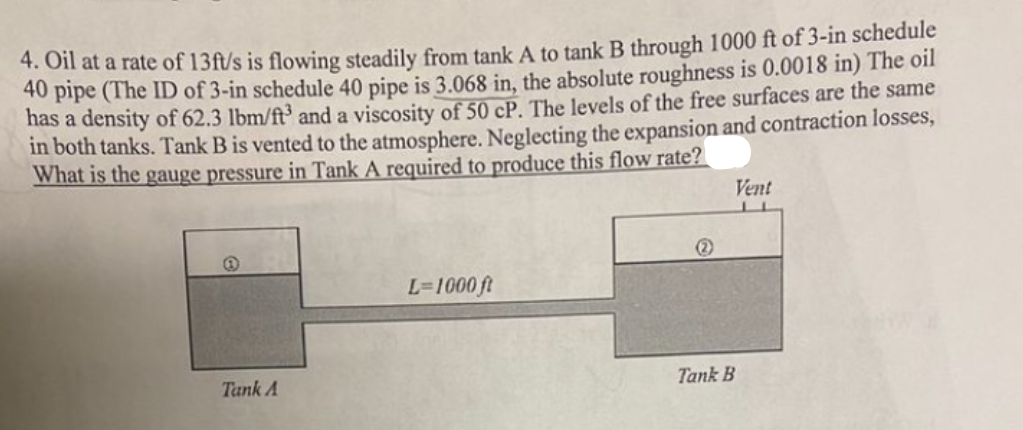4. Oil at a rate of 13ft/s is flowing steadily from tank A to tank B through 40 pipe (The ID of 3-in schedule 40 pipe is 3.068 in, the absolute roughness is 0.0018 in) The oil has a density of 62.3 lbm/ft³ and a viscosity of 50 cP. The levels of the free surfaces are the same in both tanks. Tank B is vented to the atmosphere. Neglecting the expansion and contraction losses, What is the gauge pressure in Tank A required to produce this flow rate? Tank A L=1000 ft Vent Tank B
4. Oil at a rate of 13ft/s is flowing steadily from tank A to tank B through 40 pipe (The ID of 3-in schedule 40 pipe is 3.068 in, the absolute roughness is 0.0018 in) The oil has a density of 62.3 lbm/ft³ and a viscosity of 50 cP. The levels of the free surfaces are the same in both tanks. Tank B is vented to the atmosphere. Neglecting the expansion and contraction losses, What is the gauge pressure in Tank A required to produce this flow rate? Tank A L=1000 ft Vent Tank B
Introduction to Chemical Engineering Thermodynamics
8th Edition
ISBN:9781259696527
Author:J.M. Smith Termodinamica en ingenieria quimica, Hendrick C Van Ness, Michael Abbott, Mark Swihart
Publisher:J.M. Smith Termodinamica en ingenieria quimica, Hendrick C Van Ness, Michael Abbott, Mark Swihart
Chapter1: Introduction
Section: Chapter Questions
Problem 1.1P
Related questions
Question
100%
i have calculate friction and reynolds but dont know how to calc the guage pressure needed

Transcribed Image Text:4. Oil at a rate of 13ft/s is flowing steadily from tank A to tank B through 1000 ft of 3-in schedule
40 pipe (The ID of 3-in schedule 40 pipe is 3.068 in, the absolute roughness is 0.0018 in) The oil
has a density of 62.3 lbm/ft3 and a viscosity of 50 cP. The levels of the free surfaces are the same
in both tanks. Tank B is vented to the atmosphere. Neglecting the expansion and contraction losses,
What is the gauge pressure in Tank A required to produce this flow rate?
Tank A
L=1000 ft
2
Vent
Tank B

Transcribed Image Text:f = 0.00135 1+20,000
R₂ =
€ 106
1+ (20,000 + R
pDV
μ
= 0.000888
(3.068in *
= 0.00135[1 +20,000 *
1ft)(13ft)(62.3 lbm.
ft3)
12in
50 CP 6.72 * 10-4
lbm
ft.s
= 6162.63
0.0018 inv
3.068 in
+
106
6162.63
Expert Solution
This question has been solved!
Explore an expertly crafted, step-by-step solution for a thorough understanding of key concepts.
This is a popular solution!
Trending now
This is a popular solution!
Step by step
Solved in 2 steps with 1 images

Recommended textbooks for you

Introduction to Chemical Engineering Thermodynami…
Chemical Engineering
ISBN:
9781259696527
Author:
J.M. Smith Termodinamica en ingenieria quimica, Hendrick C Van Ness, Michael Abbott, Mark Swihart
Publisher:
McGraw-Hill Education

Elementary Principles of Chemical Processes, Bind…
Chemical Engineering
ISBN:
9781118431221
Author:
Richard M. Felder, Ronald W. Rousseau, Lisa G. Bullard
Publisher:
WILEY

Elements of Chemical Reaction Engineering (5th Ed…
Chemical Engineering
ISBN:
9780133887518
Author:
H. Scott Fogler
Publisher:
Prentice Hall

Introduction to Chemical Engineering Thermodynami…
Chemical Engineering
ISBN:
9781259696527
Author:
J.M. Smith Termodinamica en ingenieria quimica, Hendrick C Van Ness, Michael Abbott, Mark Swihart
Publisher:
McGraw-Hill Education

Elementary Principles of Chemical Processes, Bind…
Chemical Engineering
ISBN:
9781118431221
Author:
Richard M. Felder, Ronald W. Rousseau, Lisa G. Bullard
Publisher:
WILEY

Elements of Chemical Reaction Engineering (5th Ed…
Chemical Engineering
ISBN:
9780133887518
Author:
H. Scott Fogler
Publisher:
Prentice Hall


Industrial Plastics: Theory and Applications
Chemical Engineering
ISBN:
9781285061238
Author:
Lokensgard, Erik
Publisher:
Delmar Cengage Learning

Unit Operations of Chemical Engineering
Chemical Engineering
ISBN:
9780072848236
Author:
Warren McCabe, Julian C. Smith, Peter Harriott
Publisher:
McGraw-Hill Companies, The